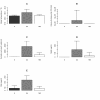In depth analysis of genes and pathways of the mammary gland involved in the pathogenesis of bovine Escherichia coli-mastitis
- PMID: 21352611
- PMCID: PMC3053262
- DOI: 10.1186/1471-2164-12-130
In depth analysis of genes and pathways of the mammary gland involved in the pathogenesis of bovine Escherichia coli-mastitis
Abstract
Background: Bovine mastitis is one of the most costly and prevalent diseases affecting dairy cows worldwide. In order to develop new strategies to prevent Escherichia coli-induced mastitis, a detailed understanding of the molecular mechanisms underlying the host immune response to an E. coli infection is necessary. To this end, we performed a global gene-expression analysis of mammary gland tissue collected from dairy cows that had been exposed to a controlled E. coli infection. Biopsy samples of healthy and infected utter tissue were collected at T = 24 h post-infection (p.i.) and at T = 192 h p.i. to represent the acute phase response (APR) and chronic stage, respectively. Differentially expressed (DE) genes for each stage were analyzed and the DE genes detected at T = 24 h were also compared to data collected from two previous E. coli mastitis studies that were carried out on post mortem tissue.
Results: Nine-hundred-eighty-two transcripts were found to be differentially expressed in infected tissue at T = 24 (P < 0.05). Up-regulated transcripts (699) were largely associated with immune response functions, while the down-regulated transcripts (229) were principally involved in fat metabolism. At T = 192 h, all of the up-regulated transcripts were associated with tissue healing processes. Comparison of T = 24 h DE genes detected in the three E. coli mastitis studies revealed 248 were common and mainly involved immune response functions. KEGG pathway analysis indicated that these genes were involved in 12 pathways related to the pro-inflammatory response and APR, but also identified significant representation of two unexpected pathways: natural killer cell-mediated cytotoxicity pathway (KEGG04650) and the Rig-I-like receptor signalling pathway (KEGG04622).
Conclusions: In E. coli-induced mastitis, infected mammary gland tissue was found to significantly up-regulate expression of genes related to the immune response and down-regulate genes related to fat metabolism. Up to 25% of the DE immune response genes common to the three E. coli mastitis studies at T = 24 h were independent of E. coli strain and dose, cow lactation stage and number, tissue collection method and gene analysis method used. Hence, these DE genes likely represent important mediators of the local APR against E. coli in the mammary gland.
Figures

Similar articles
-
Escherichia coli- and Staphylococcus aureus-induced mastitis differentially modulate transcriptional responses in neighbouring uninfected bovine mammary gland quarters.BMC Genomics. 2013 Jan 16;14:36. doi: 10.1186/1471-2164-14-36. BMC Genomics. 2013. PMID: 23324411 Free PMC article.
-
Genes and pathways revealed by whole transcriptome analysis of milk derived bovine mammary epithelial cells after Escherichia coli challenge.Vet Res. 2024 Feb 1;55(1):13. doi: 10.1186/s13567-024-01269-y. Vet Res. 2024. PMID: 38303095 Free PMC article.
-
The Impact of Intramammary Escherichia coli Challenge on Liver and Mammary Transcriptome and Cross-Talk in Dairy Cows during Early Lactation Using RNAseq.PLoS One. 2016 Jun 23;11(6):e0157480. doi: 10.1371/journal.pone.0157480. eCollection 2016. PLoS One. 2016. PMID: 27336699 Free PMC article.
-
Role of neutrophil polymorphonuclear leukocytes during bovine coliform mastitis: physiology or pathology?Verh K Acad Geneeskd Belg. 2004;66(2):97-150; discussion 150-3. Verh K Acad Geneeskd Belg. 2004. PMID: 15074078 Review.
-
The toll-like receptor-4 (TLR-4) pathway and its possible role in the pathogenesis of Escherichia coli mastitis in dairy cattle.Vet Res. 2008 Jan-Feb;39(1):5. doi: 10.1051/vetres:2007044. Epub 2007 Nov 20. Vet Res. 2008. PMID: 18073092 Review.
Cited by
-
Functional adaptations of the transcriptome to mastitis-causing pathogens: the mammary gland and beyond.J Mammary Gland Biol Neoplasia. 2011 Dec;16(4):305-22. doi: 10.1007/s10911-011-9232-2. Epub 2011 Oct 4. J Mammary Gland Biol Neoplasia. 2011. PMID: 21968536 Review.
-
Expression patterns of β-defensin and cathelicidin genes in parenchyma of bovine mammary gland infected with coagulase-positive or coagulase-negative Staphylococci.BMC Vet Res. 2014 Oct 6;10:246. doi: 10.1186/s12917-014-0246-z. BMC Vet Res. 2014. PMID: 25286984 Free PMC article.
-
Comparative proteomic analysis of proteins expression changes in the mammary tissue of cows infected with Escherichia coli mastitis.J Vet Sci. 2015;16(3):253-63. doi: 10.4142/jvs.2015.16.3.253. Epub 2014 Dec 24. J Vet Sci. 2015. PMID: 25549220 Free PMC article.
-
2,4-Thiazolidinedione in Well-Fed Lactating Dairy Goats: II. Response to Intra-Mammary Infection.Vet Sci. 2019 Jun 5;6(2):52. doi: 10.3390/vetsci6020052. Vet Sci. 2019. PMID: 31195666 Free PMC article.
-
Exploring the genetic architecture and improving genomic prediction accuracy for mastitis and milk production traits in dairy cattle by mapping variants to hepatic transcriptomic regions responsive to intra-mammary infection.Genet Sel Evol. 2017 May 12;49(1):44. doi: 10.1186/s12711-017-0319-0. Genet Sel Evol. 2017. PMID: 28499345 Free PMC article.
References
-
- Smith KL, Hogan JS. Environmental mastitis. Vet Clin North Am Food Anim Pract. 1993;9:489–498. - PubMed
Publication types
MeSH terms
LinkOut - more resources
Full Text Sources
Medical
Molecular Biology Databases
Miscellaneous

